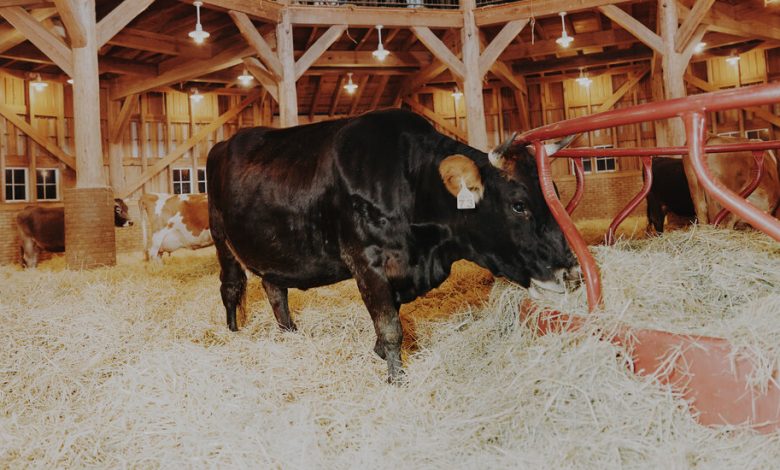Even Cows Need Some Holiday Cheer

About 200 carolers had just begun the second verse of the classic Christmas song “The Friendly Beasts” when a little girl let out a squeal of delight. About 20 feet below the balcony, on the floor of the large domed barn, two of the half-dozen dairy cows were butting heads. As the grazing heifers lifted their horns, their playful roughhousing seemed like a display of holiday cheer.
On Saturday, the Churchtown Dairy in Claverack, N.Y., once again hosted a Yuletide tradition: caroling to the herd of 28 cattle that call the cathedral-like barn their winter home. What began a decade ago as a way for the farm’s staff and their families to celebrate the herd has since grown to an annual tradition that brings locals and out-of-towners to the farm’s 250-acre property each December.
This year, preregistration for the two caroling events filled up within hours of going online. Farm staff fielded phone calls from frustrated would-be carolers, some of whom blamed an Instagram post advertising the event for its rise in popularity.

Carolers sang Yuletide classics like “The First Noel,” “Silent Night” and “Joy to the World” to the cows below.
“We’re considering adding a third night next year to accommodate all the interest,” said Grace Pullin, Churchtown’s director of partnerships and programs.
There were more than a few repeat carolers at Saturday’s event. Ashlyn St. Ours, 33, who attended her first caroling last year, called it a “beloved tradition.” This year, it even got a shout-out in her annual Christmas letter.
Another attendee, Sharon Mclees, 64, has attended for six years. Growing up around cows, Ms. Mclees said she felt comforted by the tranquillity at Churchtown. “I love the farm atmosphere,” she said. “It’s just so back to nature.”
Churchtown Dairy was founded in 2012 by Abby Aldrich Rockefeller, the granddaughter of the business magnate John D. Rockefeller, but the property has been under her family’s purview for decades. Her mother, Peggy Rockefeller, purchased the land as part of a larger acquisition of over 2,700 acres by the American Farmland Trust, an agricultural nonprofit Peggy started in 1980.
The younger Ms. Rockefeller partnered with the architect Rick Anderson to design the farm, traveling the country visiting barns for inspiration. For her, the dome is a sign of a healthy, biodynamic farm. At the event on Saturday, Mr. Anderson explained that its shape served a more practical purpose: “Cows hate corners.”
The dairy is not unique in its caroling tradition; just a few miles up the Taconic State Parkway, Hawthorne Valley Farms has been singing to its herd in a smaller event on Christmas Eve for the past 40 years. Staff members at Churchtown each had a different theory on the origins of the practice. Ms. Pullin suggested it might have been inspired by the work of the German esoteric philosopher and biodynamic farming pioneer Rudolph Steiner, who claimed that cow horns had “astral-ethereal formative powers.” Eric Vinson, a herd manager on the farm, referenced the old European myth that animals are able to communicate with humans at Christmastime. In more contemporary contexts, scientists at the University of Leicester found that cows produced more milk when played songs with less than 100 beats per minute. (R.E.M.’s “Everybody Hurts” seemed to go over especially well.)
By that logic, carols, with their measured pace, could be conducive to a happy herd.
For those who managed to snag a spot in the barn’s rafters, the evening was a celebration of cows: their majestic moos, their picturesque habitat and their unpasteurized milk, which Churchtown sells for $6 per half-gallon, plus a $2 bottle deposit fee.
The legal status of unpasteurized, or raw, milk varies from state to state; in New York, farms can sell raw milk directly to consumers. Health experts cite the risk of food-borne illnesses from pathogens like salmonella, listeria, campylobacter and E. coli, which would typically be removed in the process of heating, or pasteurizing, the milk.
While giving a tour of the farm hours before caroling, Mr. Vinson described the precautions taken at Churchtown Dairy, including regular testing and treating the cows’ udders with an iodine solution. He also extolled the milk’s purported benefits: “Raw milk is a living probiotic food. It still has the good bacteria that helps inoculate your gut and strengthen your gut biome.”
Enthusiasts will even cross state lines for the good stuff: Two carolers that evening, Nora O’Rourke, 54, and Michael Leone, 61, drove from their home in Rockaway Township, N.J., where raw milk is illegal, to Warwick, N.Y., for unpasteurized dairy.
Not everyone at the caroling event came for the milk, though: Michael O’Gara, 70, a member of the Hudson Community Choir, lamented that he couldn’t tolerate it as well as he used to. Instead, he and his wife, Bonnie, 72, along with other members of the choir, were there to lead the group in song.
Carolers, armed with illustrated songbooks, began with Christmas classics — “The First Noel,” “Silent Night,” “Joy to the World,” — before Ms. Pullin opened the floor to requests. There were shouts of “Free Bird” but the crowd eventually settled on “Feliz Navidad” as the final number of the night.
The cows wagged their tails in appreciation — or maybe they were swatting away loose hay — and for a moment, the myth seemed to come alive: Animals and humans communicating for the holiday.
